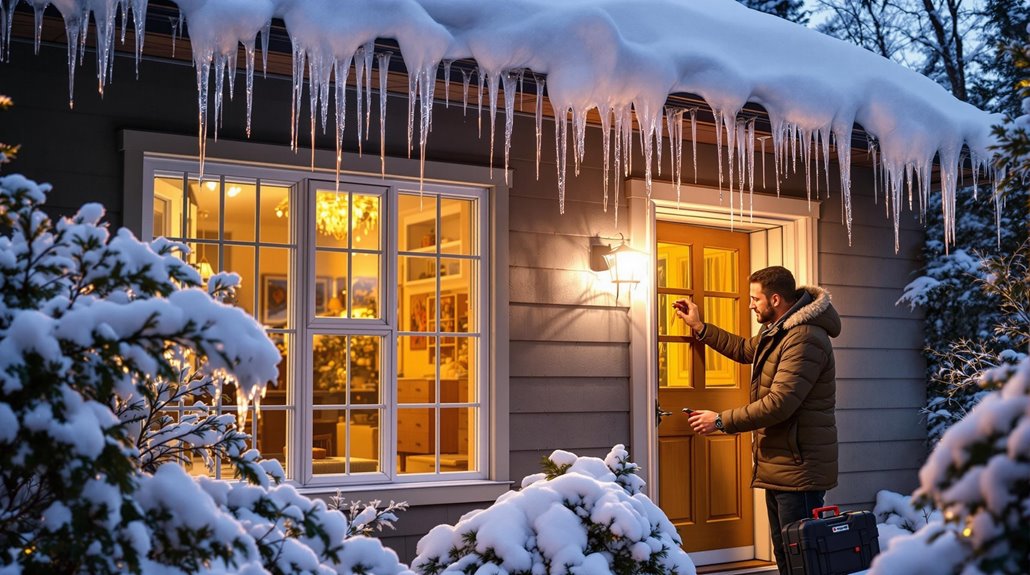Winterproofing your Smyrna home is vital for comfort and safety. Start by insulating vulnerable pipes in unheated areas to prevent freezing. Schedule an HVAC maintenance check to guarantee your heating system runs efficiently. Seal windows and doors with caulking to minimize drafts and improve energy efficiency. Inspect your roof and gutters for debris and leaks to avoid water damage. Don't forget to winterize outdoor systems and store furniture properly to resist harsh weather. Finally, create an emergency kit for power outages. These steps will keep your home safe; find more important tips to improve your winter readiness.
Key Takeaways
- Insulate vulnerable pipes in unheated areas to prevent freezing and maintain a thermostat above 55°F throughout your home.
- Schedule a professional HVAC maintenance checkup to ensure your heating system operates efficiently during winter.
- Inspect and clean gutters and roofs regularly to prevent ice accumulation and leaks from winter storms.
- Store outdoor furniture indoors or cover it securely to protect against harsh winter weather conditions.
- Prepare an emergency kit with essentials like food, water, and a battery-powered radio for unexpected winter storms.
Protecting Your Pipes
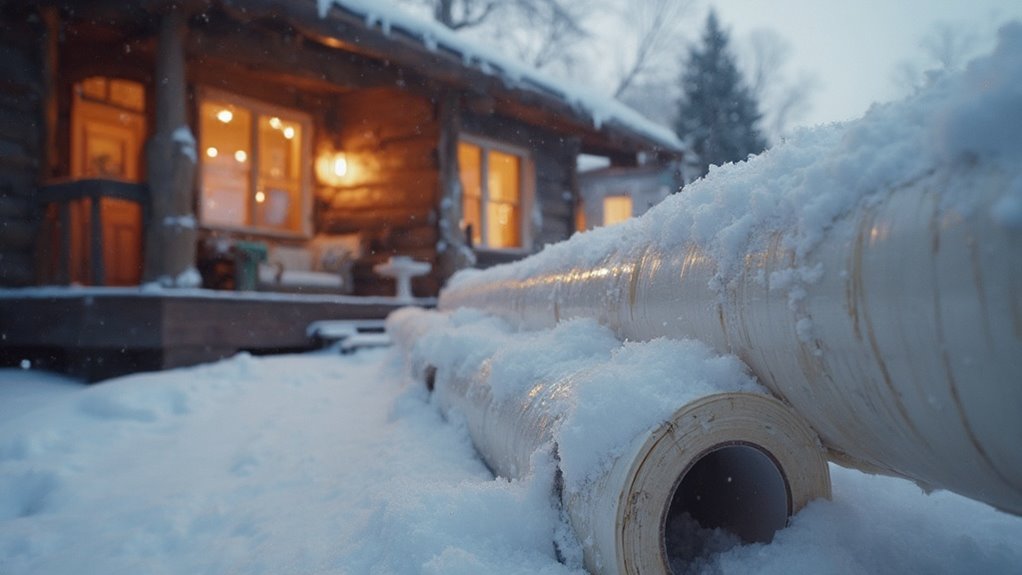
How can you assure your pipes stay safe and sound during winter? Start by insulating any vulnerable pipes located in unheated areas like attics, crawl spaces, and garages. Using materials such as foam or fiberglass for pipe insulation creates a critical barrier against the frigid air. Opt for heavy-duty R4 insulators and confirm they fit correctly—either ½ or ¾ of an inch—so that the insulation is effective.
To manage water flow, maintain your home's thermostat above 55 degrees Fahrenheit. This warmth helps prevent freezing. Keeping thermostats in outbuildings above a minimum temperature is also essential to prevent frozen pipes. Dripping cold water from the farthest faucet keeps water moving, reducing the risk of ice buildup. Don't forget to drain and disconnect hoses from outside spigots, turning off the water supply to avoid freezing pipes.
For extra protection, consider using UL-listed heat tape to warm pipes in critical areas. Moreover, open cupboards and vanities to allow warm air access to your plumbing. Additionally, prompt water removal is crucial in case of a pipe burst, as it mitigates damage and prevents mold growth. By taking these proactive steps, you can greatly reduce the likelihood of pipe bursts and guarantee your plumbing system remains operational throughout the winter months.
Roof and Gutter Maintenance
After verifying your pipes are well-protected, it's time to focus on another critical aspect of winterproofing your home: roof and gutter maintenance. Start with a thorough roof inspection. Look for loose, cracked, or missing shingles, as these can lead to moisture seepage and leaks. Pay special attention to the flashing around chimneys, skylights, and vents—make certain it's tight and intact. If you spot any signs of leaks, like water stains on walls or ceilings, address them promptly.
Next, tackle gutter cleaning. Clear your gutters and downspouts of leaves, twigs, and other debris to guarantee water flows freely. If you haven't already, consider installing gutter covers to minimize future clogs. Test your gutters using a garden hose to confirm there are no blockages, especially before winter sets in. Regularly check them throughout the winter months to prevent ice accumulation, which can lead to serious damage. Additionally, proper gutter maintenance can help prevent water damage and the growth of mold and mildew inside your home.
Insulating and Sealing Your Home
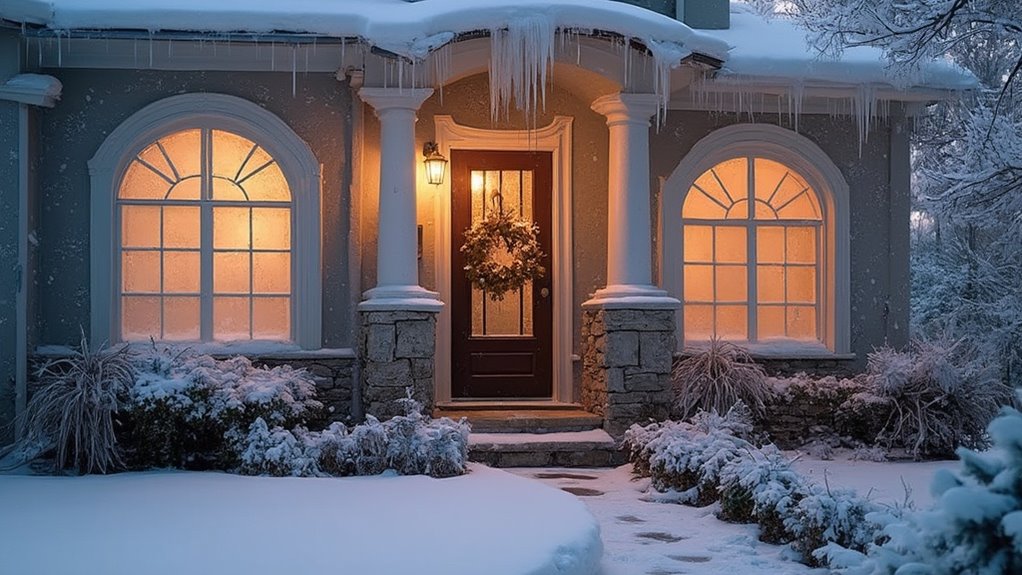
When it comes to winterproofing your home, insulating and sealing your property is essential for maintaining comfort and reducing energy costs. Start by focusing on insulation types in your walls, attic, and floors. For walls, consider spray foam insulation to keep cold air out. In attics, use fiberglass blown-in insulation to prevent heat loss. Don't forget to insulate floors above unheated spaces as well, which can greatly reduce heating bills.
To effectively seal gaps and cracks, employ various sealing techniques. Here's a quick reference table:
| Sealing Technique | Description |
|---|---|
| Weatherstripping | Use self-adhesive tape for quick fixes. |
| Caulking | Fill gaps around windows and doors. |
| Draft Stops | Block cold drafts and debris at entry points. |
Take the time to inspect and improve these areas. Proper insulation and sealing not only improve comfort but likewise lead to substantial energy savings. By mastering these techniques, you'll guarantee your home stays warm and efficient all winter long.
Preparing Your Heating System
To guarantee your heating system is ready for winter, start by scheduling a professional HVAC maintenance checkup. Regularly replacing or cleaning your air filters is essential, as dirty filters can strain your system and increase energy costs. By taking these steps, you'll improve efficiency and keep your home comfortable all season long.
Schedule HVAC Maintenance
As winter approaches, scheduling a professional HVAC checkup becomes essential for guaranteeing your heating system operates efficiently. By prioritizing this maintenance, you can improve HVAC efficiency and extend the lifespan of your system. Here's a quick maintenance checklist to guide you:
- Annual Maintenance: Schedule checkups each spring and fall to prepare your HVAC system for the seasons.
- Inspection and Cleaning: Technicians will inspect, clean, and tune your equipment, addressing minor repairs on-site.
- Thermostat Functionality: Confirm your thermostat is working correctly by testing all its functions and recalibrating if necessary.
- Safety Checks: Technicians will check for carbon monoxide leaks and other safety hazards, assuring a safe environment for your family.
Taking these steps not only improves heating efficiency but additionally prevents larger issues down the line. Remember to turn on your heating system a couple of weeks before freezing temperatures arrive, allowing time for any necessary repairs. By being proactive with your HVAC maintenance, you can enjoy a warm and comfortable home all winter long.
Replace Filters Regularly
Regularly replacing your HVAC filters is vital for keeping your heating system running efficiently throughout the winter months. Clogged filters force your HVAC system to work harder, increasing energy bills and reducing overall efficiency. By maintaining a consistent replacement schedule, you not only save money on utilities, but you likewise lower your carbon footprint.
Different filter types have varying lifespans; for example, fiberglass filters may need replacing every month, while pleated filters can last up to three months. Check your filters monthly to see if they need changing—if light can't pass through, it's time for a replacement.
Furthermore, clean filters greatly improve indoor air quality by trapping dust, dander, and mold that can worsen allergies and asthma. This contributes to a healthier home environment and reduces dust circulation, keeping your living spaces cleaner.
In addition, regular filter changes help extend the lifespan of your HVAC system. Clogged filters can lead to overheating and premature failure, stressing the blower and other components. By prioritizing filter replacement, you guarantee peak performance and reduce the need for costly repairs. Keep your heating system in prime condition this winter!
Winterizing Outdoor Systems
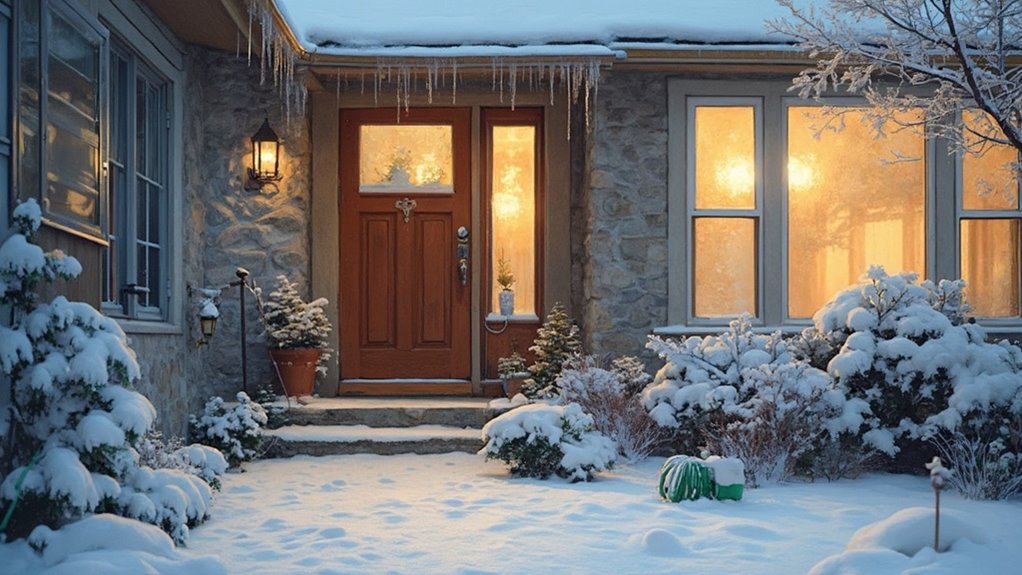
As winter approaches, it's crucial to winterize your outdoor systems to prevent costly damage. Start by shutting off the water supply to your sprinkler system and draining the lines to keep them from freezing. Moreover, store your outdoor furniture indoors or cover it securely to protect it from harsh weather conditions.
Sprinkler System Maintenance
Winterizing your outdoor sprinkler system is crucial to preventing damage during the cold months. Taking the right steps guarantees your system withstands winter's chill, allowing for seamless sprinkler system upgrades and seasonal adjustments come spring. Here's how to effectively winterize your system:
- Turn Off the Water Supply: Locate and fully close the main water valve to halt water flow.
- Drain the System: Open manual drain valves at the lowest points, and use an air compressor to blow out residual water, maintaining the correct pressure levels.
- Protect Components: Clean and store removable sprinkler heads indoors. Insulate exposed pipes and valves with foam sleeves or tarps.
- Winterize Controllers: Move your controller to a protected area or cover it with insulating material if it can't be relocated.
Outdoor Furniture Storage
Properly storing your outdoor furniture is vital for maintaining its longevity and appearance through the harsh winter months. Start by cleaning each piece with a gentle detergent and water, making sure you remove all dirt, debris, and moisture. For wooden furniture, apply a protective sealant or oil, and use a rust-resistant spray for metal items. Disassemble any removable parts to aid thorough cleaning and storage.
Once clean, utilize high-quality, waterproof furniture covers to protect against moisture and UV damage. Make certain these covers are breathable to prevent mold and mildew. On the other hand, heavy-duty tarps can serve as a reliable option when tied down securely.
Store your furniture in a garage, basement, or dedicated shed, elevating it off the ground using wooden pallets or concrete blocks to prevent moisture damage. Efficient stacking is vital; position larger items at the bottom and nest smaller items on top. Remember to store cushions separately in airtight bags to keep them mildew-free. Finally, label and store small parts, like screws and bolts, in clearly marked bags for easy reassembly come spring. Following these steps will keep your outdoor furniture in prime condition year after year.
Emergency Power Preparedness
When the power goes out, having an emergency power preparedness plan in place can make all the difference. Here are four crucial tips to guarantee your home remains safe and functional:
- Assemble Emergency Kits: Keep battery-powered radios, flashlights with fresh batteries, bottled water, and non-perishable food readily available. Don't forget a first aid kit and any prescription medicines you may need.
- Safeguard Appliances: To prevent damage from power surges when electricity returns, switch off all lights and appliances. Leave one light on to signal when power is restored, and unplug sensitive electronics.
- Verify Alternative Heating Safety: If you need to heat your home, avoid using charcoal grills or gas ovens to prevent carbon monoxide poisoning. Always operate alternative heat sources according to instructions and guarantee proper ventilation.
- Monitor Home Conditions: Keep an eye on the temperature inside your home, especially for vulnerable individuals. Dress in warm layers and cover windows at night to retain heat, and slightly open faucets to prevent pipe freezing.
Being prepared not only protects your property but likewise guarantees your family's safety during power outages.
Inspecting for Water Damage
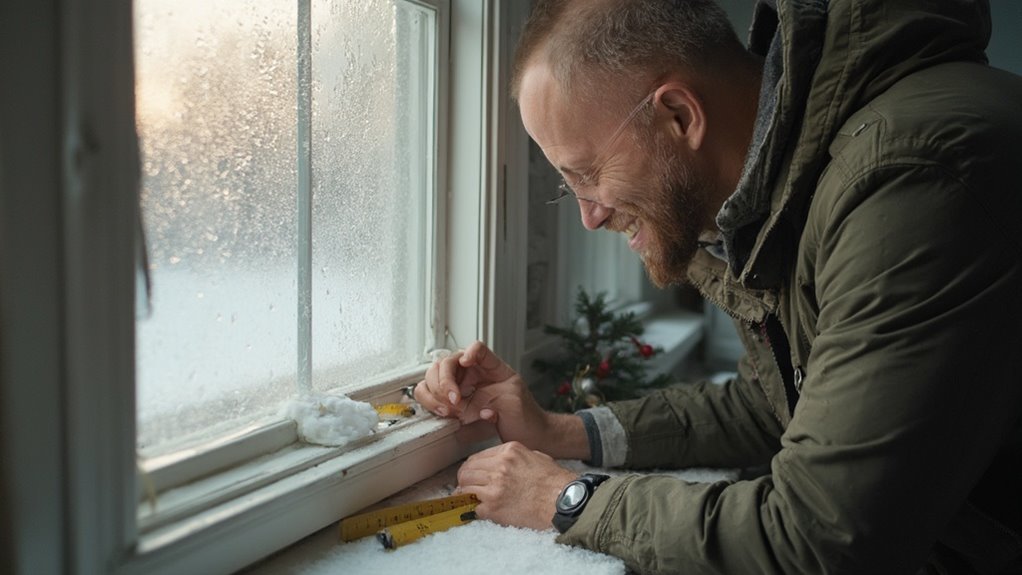
Inspecting for water damage is crucial to maintaining your home's integrity, especially during the winter months when leaks can lead to severe issues. Start by identifying the source of potential water damage, such as leaking pipes or roof leaks. Pay close attention to areas near plumbing fixtures, basements, and roofs. Use moisture assessment tools like hygrometers to measure moisture levels accurately.
Here's a quick reference table to guide your inspection process:
| Inspection Focus | Actions to Take |
|---|---|
| Identify Sources | Check plumbing, roofs, and basements |
| Look for Signs | Discoloration, damp spots, mold |
| Assess Contamination | Determine clean, gray, or black water |
| Evaluate Damage | Classify damage severity |
| Document Findings | Take clear photos and notes |
Maintaining Indoor Air Quality
Maintaining indoor air quality is essential for a healthy home environment, especially during the winter months when windows are often closed, trapping pollutants inside. To guarantee your indoor air remains clean and fresh, consider these important strategies:
- Schedule yearly HVAC maintenance to improve efficiency and air quality.
- Replace air filters every three to six months with high-quality options.
- Use air purifiers equipped with HEPA filters to eliminate allergens and pollutants.
- Incorporate indoor plants like spider plants and Boston ferns to naturally purify the air.
Improving ventilation in your home is also significant. Open windows on warm days, use ceiling fans in reverse to circulate warm air, and create air exchanges even during colder times. Managing humidity levels is similarly essential; use a humidifier to prevent dry air and monitor humidity to avoid mold growth.
Securing Outdoor Areas
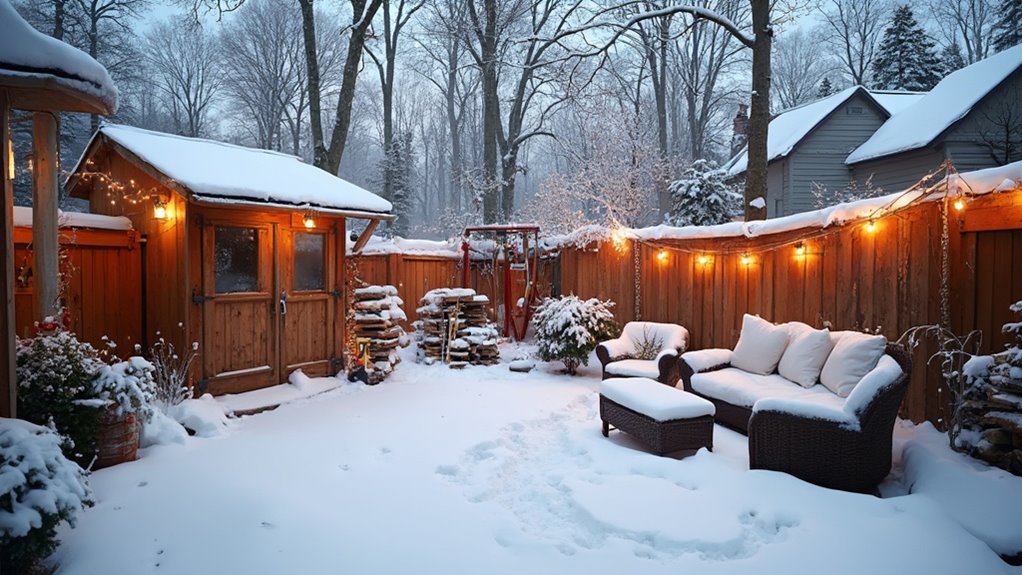
Securing your outdoor areas is vital for protecting your home from winter's harsh elements. Start by winterizing your irrigation system; shut off the water, drain the pipes, and allow air into the system to prevent any remaining water from freezing. Aim to schedule this before the first freeze, typically in early November.
Next, protect your outdoor pipes and faucets by insulating exposed piping and installing insulated covers on exterior faucets. Disconnect outdoor hoses and let faucets near outside walls drip slightly to reduce the risk of freezing.
Maintaining your roof and gutters is just as important. Inspect for missing shingles or clogged gutters, and clear any debris that could cause ice build-up.
Don't forget about hardscape and garden maintenance. Pressure wash stone paths to remove algae and apply mulch around plants to retain moisture. For added security and aesthetics, improve your outdoor lighting to illuminate pathways and highlight features in your garden preparation. These steps help guarantee your outdoor areas are ready to withstand winter, safeguarding your home's integrity and beauty.
Planning for Winter Emergencies
When winter arrives, having a solid plan for emergencies can make all the difference in keeping your family safe and comfortable. Here are four crucial steps to prepare:
- Create an Emergency Kit: Stock up on water, non-perishable food, and a first aid kit. Don't forget blankets and personal hygiene items.
- Ensure Heating and Power Systems: Service your heating systems and check your chimney. Make sure your generator is operational and fuel your oil furnace before storms hit.
- Insulate and Seal Your Home: Inspect windows and doors, and add insulation where needed. This helps prevent pipes from freezing and reduces moisture buildup.
- Plan for Communication and Safety: Develop an emergency plan with escape routes and safe spots. Post emergency contacts near your phones, and create a communication strategy that includes important numbers. Always keep a battery-powered radio handy.
Conclusion
By winterproofing your Smyrna home, you're not just protecting your property; you're ensuring comfort, safety, and peace of mind. You're safeguarding your pipes, maintaining your roof, and preparing your heating system. You're sealing drafts, checking for water damage, and keeping your indoor air clean. You're additionally securing outdoor areas and planning for emergencies. Taking these steps now means you can enjoy the winter months stress-free and cozy, knowing you've done everything to keep your home safe.



